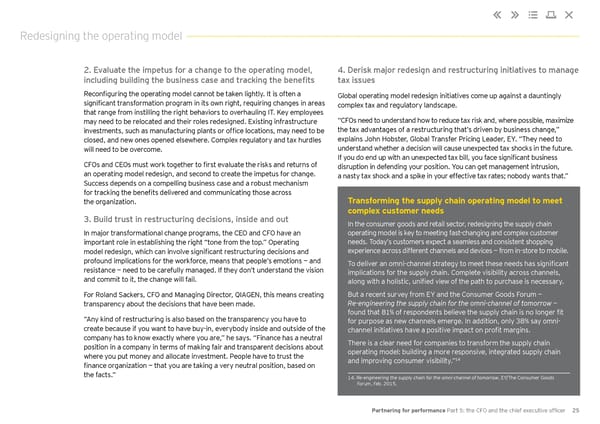Redesigning the operating model 2. Evaluate the impetus for a change to the operating model, 4. Derisk major redesign and restructuring initiatives to manage including building the business case and tracking the benefits tax issues Reconfiguring the operating model cannot be taken lightly. It is often a Global operating model redesign initiatives come up against a dauntingly significant transformation program in its own right, requiring changes in areas complex tax and regulatory landscape. that range from instilling the right behaviors to overhauling IT. Key employees may need to be relocated and their roles redesigned. Existing infrastructure “CFOs need to understand how to reduce tax risk and, where possible, maximize investments, such as manufacturing plants or office locations, may need to be the tax advantages of a restructuring that’s driven by business change,” closed, and new ones opened elsewhere. Complex regulatory and tax hurdles explains John Hobster, Global Transfer Pricing Leader, EY. “They need to will need to be overcome. understand whether a decision will cause unexpected tax shocks in the future. If you do end up with an unexpected tax bill, you face significant business CFOs and CEOs must work together to first evaluate the risks and returns of disruption in defending your position. You can get management intrusion, an operating model redesign, and second to create the impetus for change. a nasty tax shock and a spike in your effective tax rates; nobody wants that.” Success depends on a compelling business case and a robust mechanism for tracking the benefits delivered and communicating those across the organization. Transforming the supply chain operating model to meet complex customer needs 3. Build trust in restructuring decisions, inside and out In the consumer goods and retail sector, redesigning the supply chain In major transformational change programs, the CEO and CFO have an operating model is key to meeting fast-changing and complex customer important role in establishing the right “tone from the top.” Operating needs. Today’s customers expect a seamless and consistent shopping model redesign, which can involve significant restructuring decisions and experience across different channels and devices — from in-store to mobile. profound implications for the workforce, means that people’s emotions — and To deliver an omni-channel strategy to meet these needs has significant resistance — need to be carefully managed. If they don’t understand the vision implications for the supply chain. Complete visibility across channels, and commit to it, the change will fail. along with a holistic, unified view of the path to purchase is necessary. For Roland Sackers, CFO and Managing Director, QIAGEN, this means creating But a recent survey from EY and the Consumer Goods Forum — transparency about the decisions that have been made. Re-engineering the supply chain for the omni-channel of tomorrow — found that 81% of respondents believe the supply chain is no longer fit “Any kind of restructuring is also based on the transparency you have to for purpose as new channels emerge. In addition, only 38% say omni- create because if you want to have buy-in, everybody inside and outside of the channel initiatives have a positive impact on profit margins. company has to know exactly where you are,” he says. “Finance has a neutral There is a clear need for companies to transform the supply chain position in a company in terms of making fair and transparent decisions about operating model: building a more responsive, integrated supply chain where you put money and allocate investment. People have to trust the 14 finance organization — that you are taking a very neutral position, based on and improving consumer visibility.” the facts.” 14. Re-engineering the supply chain for the omni-channel of tomorrow, EY/The Consumer Goods Forum, Feb. 2015. Partnering for performance Part 5: the CFO and the chief executive officer 25
 Partnering for Performance Part 5 Page 26 Page 28
Partnering for Performance Part 5 Page 26 Page 28